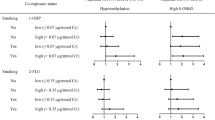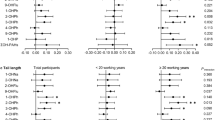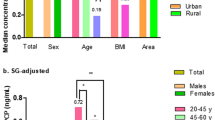Abstract
The mechanisms that long noncoding RNA (lncRNA) H19 binding to S-adenosylhomocysteine hydrolase (SAHH) interacted with DNA methyltransferase 1 (DNMT1) and then regulated DNA damage caused by polycyclic aromatic hydrocarbons (PAHs) remain unclear. A total of 146 occupational workers in a Chinese coke-oven plant in 2014 were included in the final analyses. We used high-performance liquid chromatography mass spectrometry (HPLC–MS) equipped to detect urine biomarkers of PAHs exposure, including 2-hydroxynaphthalene (2-NAP), 2-hydroxyfluorene (2-FLU), 9-hydroxyphenanthrene (9-PHE) and 1-hydroxypyrene (1-OHP). The levels of SAM and SAH in plasma were detected by HPLC-ultraviolet. By constructing various BEAS-2B cell models exposed to 16 μM benzo[a]pyrene (BaP) for 24 h, toxicological parameters reflecting distinct mechanisms were evaluated. We documented that urinary 1-hydroxypyrene (1-OHP) levels were positively associated with blood H19 RNA expression (OR: 1.51, 95% CI: 1.03–2.19), but opposite to plasma SAHH activity (OR: 0.63, 95% CI: 0.41–0.98) in coke oven workers. Moreover, by constructing various BEAS-2B cell models exposed to benzo[a]pyrene (BaP), we investigated that H19 binding to SAHH exaggerated DNMT1 expressions and activity. Suppression of H19 enhanced the interaction of SAHH and DNMT1 in BaP-treated cells, decreased eight-oxoguanine DNA glycosylase 1 (OGG1) methylation, reduced oxidative DNA damage and lessened S phase arrest. However, SAHH or DNMT1 single knockdown and SAHH/DNMT1 double knockdown showed the opposite trend. A H19/SAHH/DNMT1 axis was involved in OGG1 methylation, oxidative DNA damage and cell cycle arrest by carcinogen BaP.




Similar content being viewed by others
Data availability
Not applicable.
Abbreviations
- 1-OHP:
-
1-Hydroxypyrene
- 2-FLU:
-
2-Hydroxyfluorene
- 2-NAP:
-
2-Hydroxynaphthalene
- 9-PHE:
-
9-Hydroxyphenanthrene
- aa:
-
Amino acid
- BaP:
-
Benzo[a]pyrene
- BER:
-
Base excision repair
- DNMT:
-
DNA methyltransferase
- lncRNAs:
-
Long noncoding RNAs
- OGG1 :
-
Eight-oxoguanine DNA glycosylase 1
- PAHs:
-
Polycyclic aromatic hydrocarbons
- ROS:
-
Reactive oxygen species
- SAH:
-
S-Adenosylhomocysteine
- SAHH:
-
S-Adenosylhomocysteine hydrolase
- SAM:
-
S-Adenosylmethionine
References
Alvarado-Cruz I, Sánchez-Guerra M, Hernández-Cadena L et al (2017) Increased methylation of repetitive elements and DNA repair genes is associated with higher DNA oxidation in children in an urbanized, industrial environment. Mutat Res 813:27–36
Andres JL, Fan S, Turkel GJ et al (1998) Regulation of BRCA1 and BRCA2 expression in human breast cancer cells by DNA-damaging agents. Oncogene 16(17):2229–2241
Andrysik Z, Vondracek J, Machala M et al (2007) The aryl hydrocarbon receptor-dependent deregulation of cell cycle control induced by polycyclic aromatic hydrocarbons in rat liver epithelial cells. Mutat Res 615(1–2):87–97
Beluzić R, Cuk M, Pavkov T et al (2008) S-Adenosylhomocysteine hydrolase (AdoHcyase) deficiency: enzymatic capabilities of human AdoHcyase are highly effected by changes to codon 89 and its surrounding residues. Biochem Biophys Res Commun 368(1):30–36
Campo L, Hanchi M, Sucato S, et al (2020) Biological monitoring of occupational exposure to metals in electric steel foundry workers and its contribution to 8-oxo-7,8-dihydro-2′-deoxyguanosine levels. Int J Environ Res Public Health 17(6):1811
Castillejos M, Borja-Aburto VH, Dockery DW et al (2000) Airborne coarse particles and mortality. Inhal Toxicol 12(sup1):61–72
Chen C, Liu M, Tang Y et al (2020) LncRNA H19 is involved in myocardial ischemic preconditioning via increasing the stability of nucleolin protein. J Cell Physiol 235(9):5985–5994
Chen LL (2016) Linking long noncoding RNA localization and function. Trends Biochem Sci 41(9):761–772
Davalli P, Marverti G, Lauriola A et al (2018) Targeting oxidatively induced DNA damage response in cancer: opportunities for novel cancer therapies. Oxid Med Cell Longev 2018:2389523
Fe Dra LM, Anna HA, Noemi C et al (2017) Nutrients in energy and one-carbon metabolism: learning from metformin users. Nutrients 9(2):121
Fu Y, Niu Y, Pan B et al (2019) OGG1 methylation mediated the effects of cell cycle and oxidative DNA damage related to PAHs exposure in Chinese coke oven workers. Chemosphere 224:48–57
Fu Y, Wang W, Li X et al (2018) LncRNA H19 interacts with S-adenosylhomocysteine hydrolase to regulate LINE-1 methylation in human lung-derived cells exposed to benzo[a]pyrene. Chemosphere 207:84–90
Gonçalves AC, Alves R, Baldeiras I et al (2017) Genetic variants involved in oxidative stress, base excision repair, DNA methylation, and folate metabolism pathways influence myeloid neoplasias susceptibility and prognosis. Mol Carcinog 56(1):130–148
Herbstman JB, Tang D, Zhu D et al (2012) Prenatal exposure to polycyclic aromatic hydrocarbons, benzo[a]pyrene–DNA adducts, and genomic DNA methylation in cord blood. Environ Health Perspect 120(5):733–738
Hernandez-Cortes D, Alvarado-Cruz I, SolãS-Heredia MJ et al (2018) Epigenetic modulation of Nrf2 and Ogg1 gene expression in testicular germ cells by methyl parathion exposure. Toxicol Appl Pharmacol 346:19–27
Hruba E, Trilecova L, Marvanova S et al (2010) Genotoxic polycyclic aromatic hydrocarbons fail to induce the p53-dependent DNA damage response, apoptosis or cell-cycle arrest in human prostate carcinoma LNCaP cells. Toxicol Lett 197(3):227–235
Idowu O, Semple KT, Ramadass K et al (2019) Beyond the obvious: environmental health implications of polar polycyclic aromatic hydrocarbons. Environ Int 123:543–557
Illamola SM, Echaabi AK, Mazeron C et al (2019) Development and validation of a UPLC-UV method for the quantification of thiopurine methyltransferase enzyme activity in human erythrocytes. J Chromatogr B Analyt Technol Biomed Life Sci 1113:91–97
Kanduri C (2015) Long noncoding RNAs: lessons from genomic imprinting. Biochem Biophys Acta 1859(1):102–111
Klungland A, Bjelland S (2007) Oxidative damage to purines in DNA: role of mammalian OGG1. DNA Repair (amst) 6(4):481–488
Li Q, Zhu L, Yan Y et al (2013) S-Adenosyl homocysteine hydrolase (SAHH) accelerates flagellar regeneration in Dunaliella salina. Curr Microbiol 67(2):249–254
Moorthy B, Chu C, Carlin DJ (2015) Polycyclic aromatic hydrocarbons: from metabolism to lung cancer. Toxicol Sci 145(1):5–15
Oksana T, Nermina M et al (2013) S-Adenosyl-L-homocysteine hydrolase and methylation disorders: yeast as a model system. Biochimica Et Biophysica Acta 1:204–215
Oksana T, Meinhard H, Kohlwein SD (2004) S-Adenosyl-L-homocysteine hydrolase in yeast: key enzyme of methylation metabolism and coordinated regulation with phospholipid synthesis. FEBS Lett 577(3):501–506
Olujimi OO, Ogunseye OO, Oladiran KO et al (2018) Preliminary investigation into urinary 1-hydroxypyrene as a biomarker for polycyclic aromatic hydrocarbons exposure among charcoal workers in Ogun and Oyo states. Nigeria Saf Health Work 9(4):416–420
Petit P, Maitre A, Persoons R et al (2019) Lung cancer risk assessment for workers exposed to polycyclic aromatic hydrocarbons in various industries. Environ Int 124:109–120
Ponnaluri VKC, Esteve PO, Ruse CI et al (2018) S-Adenosylhomocysteine hydrolase participates in DNA methylation inheritance. J Mol Biol 430(14):2051–2065
Porcelli M, Fusco S, Inizio T et al (2000) Expression, purification, and characterization of recombinant S-adenosylhomocysteine hydrolase from the thermophilic archaeon Sulfolobus solfataricus. Protein Expr Purif 18(1):27–35
Tibbetts AS, Appling DR (2010) Compartmentalization of mammalian folate-mediated one-carbon metabolism. Annu Rev Nutr 30:57–81
Wang J, Sun J, Yang F (2020) The role of long non-coding RNA H19 in breast cancer. Oncol Lett 19(1):7–16
Wang J, Xie S, Yang J et al (2019) The long noncoding RNA H19 promotes tamoxifen resistance in breast cancer via autophagy. J Hematol Oncol 12(1):81
Whitaker AM, Schaich MA, Smith MR et al (2017) Base excision repair of oxidative DNA damage: from mechanism to disease. Front Biosci (landmark Ed) 22(9):1493–1522
Yang J, Liu X, Niu P et al (2009) Correlations and co-localizations of Hsp70 with XPA, XPG in human bronchial epithelia cells exposed to benzo[a]pyrene. Toxicology 265(1–2):10–14
Yang J, Zhang H, Zhang H et al (2017) Smoking modify the effects of polycyclic aromatic hydrocarbons exposure on oxidative damage to DNA in coke oven workers. Int Arch Occup Environ Health 90(5):1–9
Zhong T, Men Y, Lu L et al (2017) Metformin alters DNA methylation genome-wide via the H19/SAHH axis. Oncogene 36(17):2345–2354
Zhou J, Yang L, Zhong T et al (2015) H19 lncRNA alters DNA methylation genome wide by regulating S-adenosylhomocysteine hydrolase. Nat Commun 6:10221–10233
Acknowledgements
We thank all researchers and study population from General Hospital of Taiyuan Iron & Steel (Group) Co., Ltd. and Center of Occupational Disease Prevention of Xishan Coal Electricity (Group) Co., Ltd.
Funding
This project was supported by the grants from National Nature Science Foundation of China (No. 81273041), Research Project Supported by Shanxi Scholarship Council of China (No. HGKY2019053), Natural Science Foundation of Shanxi Province of China (No. 202103021224230), and Foundation for Talent start-up of Hubei University of Medicine (2021QDJZR027).
Author information
Authors and Affiliations
Contributions
Ye Fu: designed research, performed research, contributed new reagents or analytic tools, analysed data, wrote the paper. Xuejing Li: designed research, performed research, analysed data, wrote the paper. Baolong Pan: performed research, contributed new reagents or analytic tools, wrote the paper. Yingying Niu: performed research, analysed data, wrote the paper. Bin Zhang: analysed data, wrote the paper. Xinyu Zhao: analysed data, wrote the paper. Jisheng Nie: project administration, wrote the paper. Jin Yang: funding acquisition, project administration, designed research, performed research, analysed data, wrote the paper.
Corresponding author
Ethics declarations
Ethics approval and consent to participate
Our research was approved by the Ethical Review Board of the School of Public Health, Shanxi Medical University, Shanxi, People’s Republic of China.
Consent for publication
Not applicable.
Competing interests
The authors declare no competing interests.
Additional information
Responsible Editor: Mohamed M. Abdel-Daim
Publisher's note
Springer Nature remains neutral with regard to jurisdictional claims in published maps and institutional affiliations.
Supplementary Information
Below is the link to the electronic supplementary material.
Rights and permissions
Springer Nature or its licensor holds exclusive rights to this article under a publishing agreement with the author(s) or other rightsholder(s); author self-archiving of the accepted manuscript version of this article is solely governed by the terms of such publishing agreement and applicable law.
About this article
Cite this article
Fu, Y., Li, X., Pan, B. et al. Effects of H19/SAHH/DNMT1 on the oxidative DNA damage related to benzo[a]pyrene exposure. Environ Sci Pollut Res 30, 11706–11718 (2023). https://doi.org/10.1007/s11356-022-22936-7
Received:
Accepted:
Published:
Issue Date:
DOI: https://doi.org/10.1007/s11356-022-22936-7




